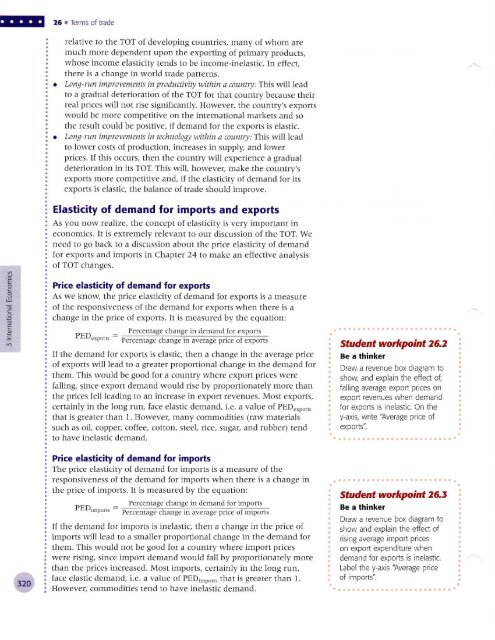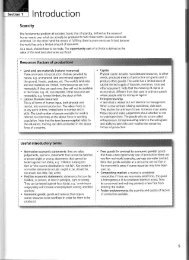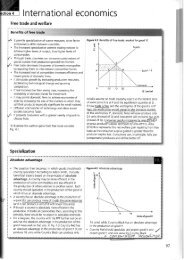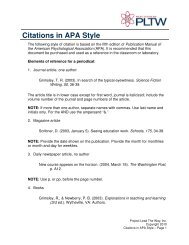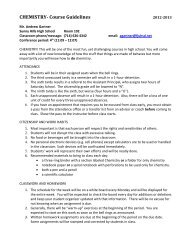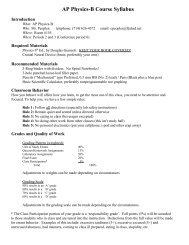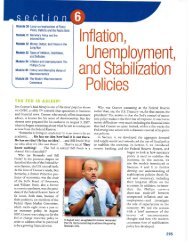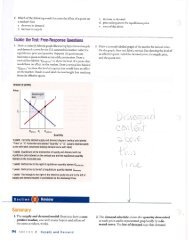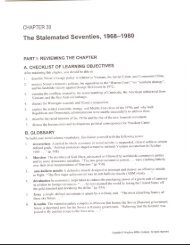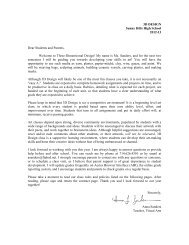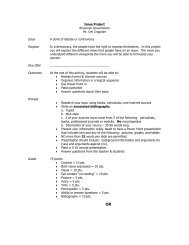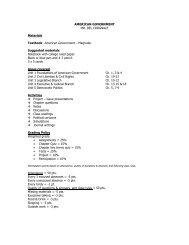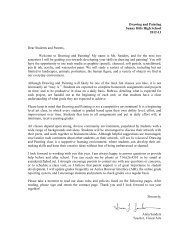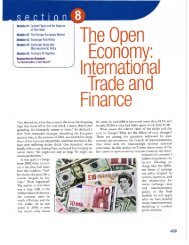IB Econ Chap 26 Terms of Trade - Sunny Hills High School
IB Econ Chap 26 Terms of Trade - Sunny Hills High School
IB Econ Chap 26 Terms of Trade - Sunny Hills High School
Create successful ePaper yourself
Turn your PDF publications into a flip-book with our unique Google optimized e-Paper software.
[!<br />
<strong>26</strong> . <strong>Terms</strong> <strong>of</strong> trade<br />
relative to the TOT oI developing countries, many <strong>of</strong> whom are<br />
much more dependent upon the exponing <strong>of</strong> primary products,<br />
whose income elasticity tends to be income-inelastic. In effect,<br />
there is a change in world trade patterns.<br />
Long-run improvements in productivity within a counry: This will lead<br />
to a gradual deterioration <strong>of</strong> the TOT for that country because their<br />
real prices will not rise significaltly. However, the country's exports<br />
would be more competitive on the international markets and so<br />
the result could be positive, if demand for the expots is elastic.<br />
Long-run improvemmts in technology within a uuntry : This will lead<br />
to lower costs <strong>of</strong> production, increases in supply, and lower<br />
prices. If this occurs, then the country will experience a gradual<br />
deterioralion in its TOT. This will, however, make the country's<br />
exports more competitive and, if the elasticity <strong>of</strong> demand for its<br />
exports is elastic, the balance <strong>of</strong> trade should improve.<br />
Elasticity <strong>of</strong> demand for imports and expods<br />
As you now realize, the concept <strong>of</strong> elasticity is very imponant in<br />
economics. It is extremely relevant to our discussion <strong>of</strong> the TOT. We<br />
need to go back to a discussion about the price elasticity <strong>of</strong> demand<br />
for exports and imports in <strong>Chap</strong>ter 24 to make an e{fective analysis<br />
<strong>of</strong> TOT changes.<br />
Price elasticity <strong>of</strong> demand for exports<br />
As we know, the price elasticity <strong>of</strong> demand for exports is a measure<br />
<strong>of</strong> the responsiveness <strong>of</strong> the demand for exports when there is a<br />
change in the price <strong>of</strong> exports. It is measured by the equation:<br />
Percentage change in demand for exports<br />
PED....', = Percentage change in average price <strong>of</strong> erTorts<br />
If the demand for exports is elastic, then a change in the average price<br />
<strong>of</strong> exports will lead to a greater proportional change in the demand for<br />
them. This would be good for a country where export prices were<br />
falling, since export demand would rise by proponionately more than<br />
the prices fell leadilg to an increase in export revenues. Most ex?orts,<br />
certainly in the long run, face elastic demand, i.e. a value <strong>of</strong> PED."pon,<br />
that is greater than I. However, many commodities (raw materials<br />
such as oil, copper, c<strong>of</strong>fee, cotton, steel, rice, sugar, and rubber) tend<br />
to have inelastic demand.<br />
Price elasticity <strong>of</strong> demand for imports<br />
The price elasticity <strong>of</strong> demand for imports is a measure <strong>of</strong> the<br />
responsiveness <strong>of</strong> the demand for imports when there is a change in<br />
the price <strong>of</strong> imports. It is measured by the equation:<br />
Percentage change in demand for imports<br />
PEDi,rp<strong>of</strong>ts : Percentage change in average price <strong>of</strong> imports<br />
If the demand for imports is inelastic, then a change in the price <strong>of</strong><br />
imports will lead to a smaller proportional change in the demand Ior<br />
them. This would not be good for a country where import pdces<br />
were rising, since import demand would fall by proportionately more<br />
than the prices increased. Most imports, certainly in the long run,<br />
face elastic demand, i.e. a value <strong>of</strong> PED6oo,ts that is greater than I.<br />
However, commodities tend to have inelastic demand.<br />
Student workpoint <strong>26</strong>.2<br />
Be a thinker<br />
Draw a revenue box diagram to<br />
show and explain the effect <strong>of</strong>,<br />
falling average export prices on<br />
export revenues when demand<br />
for exports is inelastic. On the<br />
y-axis, write "Average price <strong>of</strong><br />
exports".<br />
Student workpoint <strong>26</strong>.7<br />
Be a thinker<br />
Draw a revenue box diagram to<br />
show and explain the effect <strong>of</strong><br />
rising average import prices<br />
on export expenditure when<br />
demand for exports is inelastic.<br />
Label the y-axis 'Average price<br />
<strong>of</strong> imports".


